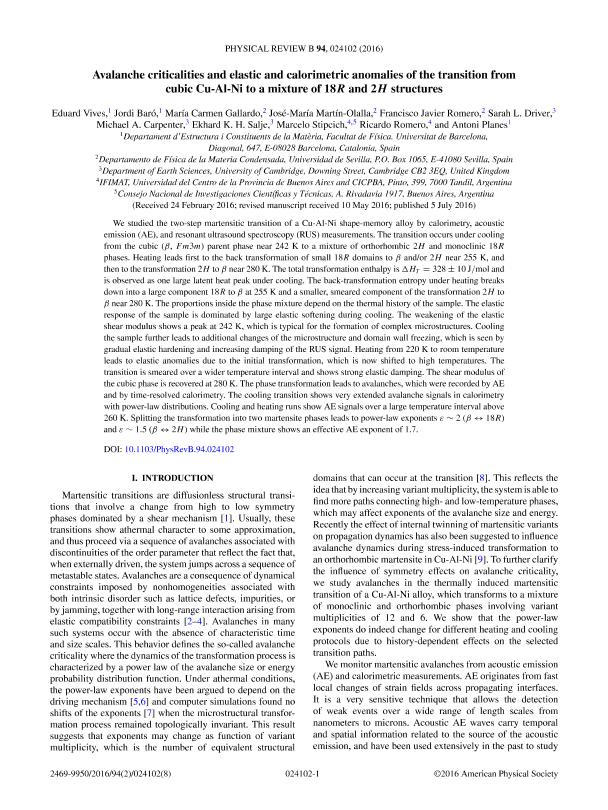Mostrar el registro sencillo del ítem
dc.contributor.author
Vives, Eduard
dc.contributor.author
Baró, Jordi
dc.contributor.author
Gallardo, María Carmen
dc.contributor.author
Martín Olalla, José María
dc.contributor.author
Romero, Francisco Javier
dc.contributor.author
Driver, Sarah L.
dc.contributor.author
Carpenter, Michael A.
dc.contributor.author
Salje, Ekhard K. H.
dc.contributor.author
Stipcich, Marcelo Fernando

dc.contributor.author
Romero, Ricardo
dc.contributor.author
Planes, Antoni
dc.date.available
2018-09-07T17:39:22Z
dc.date.issued
2016-07
dc.identifier.citation
Vives, Eduard; Baró, Jordi; Gallardo, María Carmen; Martín Olalla, José María; Romero, Francisco Javier; et al.; Avalanche criticalities and elastic and calorimetric anomalies of the transition from cubic Cu-Al-Ni to a mixture of 18R and 2H structures; American Physical Society; Physical Review B; 94; 2; 7-2016; 1-8; 024102
dc.identifier.issn
2469-9969
dc.identifier.uri
http://hdl.handle.net/11336/58726
dc.description.abstract
We studied the two-step martensitic transition of a Cu-Al-Ni shape-memory alloy by calorimetry, acoustic emission (AE), and resonant ultrasound spectroscopy (RUS) measurements. The transition occurs under cooling from the cubic (β, Fm3m) parent phase near 242 K to a mixture of orthorhombic 2H and monoclinic 18R phases. Heating leads first to the back transformation of small 18R domains to β and/or 2H near 255 K, and then to the transformation 2H to β near 280 K. The total transformation enthalpy is ΔHT=328±10 J/mol and is observed as one large latent heat peak under cooling. The back-transformation entropy under heating breaks down into a large component 18R to β at 255 K and a smaller, smeared component of the transformation 2H to β near 280 K. The proportions inside the phase mixture depend on the thermal history of the sample. The elastic response of the sample is dominated by large elastic softening during cooling. The weakening of the elastic shear modulus shows a peak at 242 K, which is typical for the formation of complex microstructures. Cooling the sample further leads to additional changes of the microstructure and domain wall freezing, which is seen by gradual elastic hardening and increasing damping of the RUS signal. Heating from 220 K to room temperature leads to elastic anomalies due to the initial transformation, which is now shifted to high temperatures. The transition is smeared over a wider temperature interval and shows strong elastic damping. The shear modulus of the cubic phase is recovered at 280 K. The phase transformation leads to avalanches, which were recorded by AE and by time-resolved calorimetry. The cooling transition shows very extended avalanche signals in calorimetry with power-law distributions. Cooling and heating runs show AE signals over a large temperature interval above 260 K. Splitting the transformation into two martensite phases leads to power-law exponents ∼2 (β↔ 18R) and ∼1.5 (β↔ 2H) while the phase mixture shows an effective AE exponent of 1.7.
dc.format
application/pdf
dc.language.iso
eng
dc.publisher
American Physical Society

dc.rights
info:eu-repo/semantics/openAccess
dc.rights.uri
https://creativecommons.org/licenses/by-nc-sa/2.5/ar/
dc.subject
Calorimetry
dc.subject
Acoustic Emission
dc.subject
Resonant Ultrasound Spectroscopy
dc.subject.classification
Otras Ciencias Físicas

dc.subject.classification
Ciencias Físicas

dc.subject.classification
CIENCIAS NATURALES Y EXACTAS

dc.title
Avalanche criticalities and elastic and calorimetric anomalies of the transition from cubic Cu-Al-Ni to a mixture of 18R and 2H structures
dc.type
info:eu-repo/semantics/article
dc.type
info:ar-repo/semantics/artículo
dc.type
info:eu-repo/semantics/publishedVersion
dc.date.updated
2018-09-07T13:37:05Z
dc.journal.volume
94
dc.journal.number
2
dc.journal.pagination
1-8; 024102
dc.journal.pais
Estados Unidos

dc.journal.ciudad
Nueva York
dc.description.fil
Fil: Vives, Eduard. Universidad de Barcelona; España
dc.description.fil
Fil: Baró, Jordi. Universidad de Barcelona; España
dc.description.fil
Fil: Gallardo, María Carmen. Universidad de Sevilla; España
dc.description.fil
Fil: Martín Olalla, José María. Universidad de Sevilla; España
dc.description.fil
Fil: Romero, Francisco Javier. Universidad de Sevilla; España
dc.description.fil
Fil: Driver, Sarah L.. University of Cambridge; Reino Unido
dc.description.fil
Fil: Carpenter, Michael A.. University of Cambridge; Reino Unido
dc.description.fil
Fil: Salje, Ekhard K. H.. University of Cambridge; Reino Unido
dc.description.fil
Fil: Stipcich, Marcelo Fernando. Universidad Nacional del Centro de la Provincia de Buenos Aires. Facultad de Ciencias Exactas. Instituto de Física de Materiales; Argentina. Provincia de Buenos Aires. Gobernación. Comisión de Investigaciones Científicas; Argentina. Consejo Nacional de Investigaciones Científicas y Técnicas; Argentina
dc.description.fil
Fil: Romero, Ricardo. Universidad Nacional del Centro de la Provincia de Buenos Aires. Facultad de Ciencias Exactas. Instituto de Física de Materiales; Argentina. Provincia de Buenos Aires. Gobernación. Comisión de Investigaciones Científicas; Argentina
dc.description.fil
Fil: Planes, Antoni. Universidad de Barcelona; España
dc.journal.title
Physical Review B

dc.relation.alternativeid
info:eu-repo/semantics/altIdentifier/doi/http://dx.doi.org/10.1103/PhysRevB.94.024102
dc.relation.alternativeid
info:eu-repo/semantics/altIdentifier/url/https://journals.aps.org/prb/abstract/10.1103/PhysRevB.94.024102
Archivos asociados
